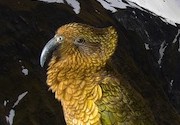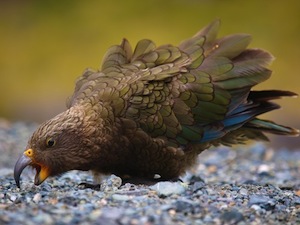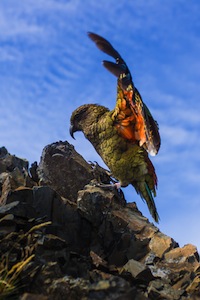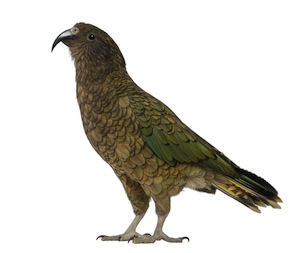
The Souless Flesh-Eating Kea
for The Last Word on NothingIn the Southern summer of 2004, my then-girlfriend and I were camped in a shelter near a rock climbing area in New Zealand called Flock Hill. It was a gorgeous landscape, sweeping grassy hills made famous as Rohan in the “Lord of the Rings” and glacial erratics from the final battle scene in “The Lion, the Witch and the Wardrobe.”
Itinerant climbers regularly blow in and out with the good weather so no one at the camp noticed late one night when a hulking black pickup rolled in or when its occupants set up a tent and passed out.
It’s a pity. Because we could have warned them.
The next day, they woke up to the wreckage of their vacation. The straps connecting their tent to the stakes in the ground were chewed out, such that half the tent had collapsed in on them. One hiking boot was found mangled 30 feet away and another was never recovered. The rubber around their windshield was shredded and their antenna had been ripped off and dropped in the truck bed. When they woke, the perpetrators – a group of mountain parrots called the keas – were gathered on their truck to inspect their work and drop branches on the hood from 10 feet up.
The truck left that morning and was never seen again. The rest of our time in Flock Hill was marred by these horrid little creatures, whose screeching call woke us up at 6AM every morning. Keas are large, menacing parrots recognizable by their brownish-green backs and a glint of sociopathy in their beady little eyes. In the moments before dawn, they crept about, silently tugging on tire spouts, pulling apart windshield wipers, and eating our side mirrors. My buddy Dan, whose van resembled a tank that frustrated attempts to rip it apart, even discovered one day that they had chewed out several hoses in the undercarriage.
 The kea is a legendary marauder of the mountains of New Zealand’s south island and are often called the clown of the mountains. Maybe – if by “clown” you mean a Stephen King knife-wielding psycho. They are highly intelligent and happily steal clothing, building supplies, or any rubber they can get their grubby beaks on.
The kea is a legendary marauder of the mountains of New Zealand’s south island and are often called the clown of the mountains. Maybe – if by “clown” you mean a Stephen King knife-wielding psycho. They are highly intelligent and happily steal clothing, building supplies, or any rubber they can get their grubby beaks on.
In addition to eating cars, it’s recently been confirmed that they can kill sheep. That’s right, these merciless flying killers gang up on sheep and viciously pick at their fat until the beasts bleed to death. Do you see the danger here? New Zealand has more sheep than people – an order of magnitude more.
Thus, it stands to reason that the only reason they haven’t begun attacking humans is that, statistically speaking, they just haven’t encountered enough of us. It’s the fat from the soft underbellies that they crave. The Kiwis, as we know are skinnier than we Americans (and for some reason, far less likely to wear shoes outside). So what happens when these hyper-intelligent, fat-craving, psychopathic killing machines discover a new country where the people are fatter and slower than sheep? Carnage, that’s what.
My girlfriend (now wife) saw this firsthand nine years ago when she was collecting water from the stream. She knelt down in a lowered streambed, making it look like she was far smaller than she was. A gang of keas immediately wandered over, bloody murder written all over their grinning little faces. When she stood up to her full height, they immediately stopped and pretended to be fascinated with the grass at their feet.
In 2012 alone, keas were responsible for $425 million in damages and 5 deaths. And while it’s true those statistics aren’t based on real data and that I just made them up, they are nonetheless startling. Of course many environmentalists point out that keas are under threat from poisoning and that at least 150,000 have been killed to protect sheep.
 That’s a lot. But I say it’s not nearly enough. Most people who are worried about keas I imagine have never met one. Endangered or threatened animals should fall into one of two categories. One, they are sad and pleading, like baby harp seals, baby polar bears, or panda bears (baby and otherwise). Or they should be majestic, like bald eagles, adult polar bears, or mountain lions. But the kea is neither of these. They are self-righteous, disrespectful ingrates whose daily behavior can only be described as dickish.
That’s a lot. But I say it’s not nearly enough. Most people who are worried about keas I imagine have never met one. Endangered or threatened animals should fall into one of two categories. One, they are sad and pleading, like baby harp seals, baby polar bears, or panda bears (baby and otherwise). Or they should be majestic, like bald eagles, adult polar bears, or mountain lions. But the kea is neither of these. They are self-righteous, disrespectful ingrates whose daily behavior can only be described as dickish.
In my last blog for this site, I posed a genuinely provocative question: When is it time to let a species go? But that was in reference to the quiet and tragic Mexican porpoise, who understands what it means to be a respectful species under siege. The kea, meanwhile, has no respect for humans and replaces majesty with feathered douchebagery. It seems to know that it’s protected by law and flaunts that fact in your face, daring you to reciprocate its violent provocations.
When it comes to these fluffy hoodlums, a better question is: When is it time to spitefully wipe out a species? I mean, we’re humans. We have to keep our freaking dignity.
You may laugh because this is a tiny population trapped on an island, but you would be foolish to do so. Remember that birds can fly. And while most birds are adorable soulful creatures, scientists have recently proved that keas don’t have souls and think of nothing all day long but death and destruction. What’s to stop this shoulder-parrot-of-Satan from crossing the tiny Pacific and assaulting the entire Western Seaboard?
Ignore this warning if you want. But when you find a hulking parrot with soulless eyes pulling at your soft underbelly – well just remember that I warned you.
Photos courtesy ofShutterstock.
